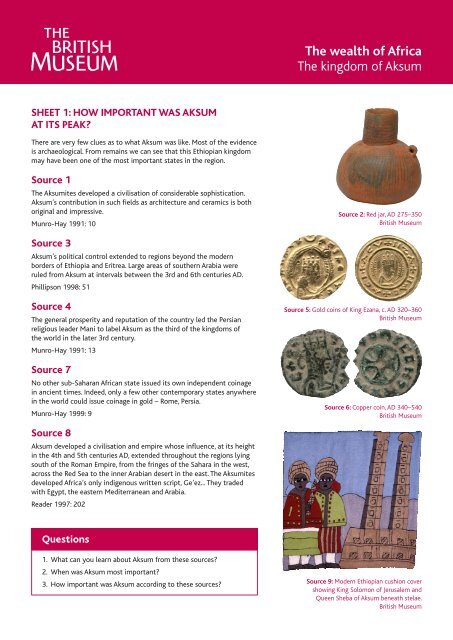The wealth of Africa The kingdom of Aksum - British Museum
The wealth of Africa The kingdom of Aksum - British Museum
The wealth of Africa The kingdom of Aksum - British Museum
Create successful ePaper yourself
Turn your PDF publications into a flip-book with our unique Google optimized e-Paper software.
SHEET 1: HOW IMPORTANT WAS AKSUM<br />
AT ITS PEAK?<br />
<strong>The</strong>re are very few clues as to what <strong>Aksum</strong> was like. Most <strong>of</strong> the evidence<br />
is archaeological. From remains we can see that this Ethiopian <strong>kingdom</strong><br />
may have been one <strong>of</strong> the most important states in the region.<br />
Source 1<br />
<strong>The</strong> <strong>Aksum</strong>ites developed a civilisation <strong>of</strong> considerable sophistication.<br />
<strong>Aksum</strong>’s contribution in such fields as architecture and ceramics is both<br />
original and impressive.<br />
Munro-Hay 1991: 10<br />
Source 3<br />
<strong>Aksum</strong>’s political control extended to regions beyond the modern<br />
borders <strong>of</strong> Ethiopia and Eritrea. Large areas <strong>of</strong> southern Arabia were<br />
ruled from <strong>Aksum</strong> at intervals between the 3rd and 6th centuries AD.<br />
Phillipson 1998: 51<br />
Source 4<br />
<strong>The</strong> general prosperity and reputation <strong>of</strong> the country led the Persian<br />
religious leader Mani to label <strong>Aksum</strong> as the third <strong>of</strong> the <strong>kingdom</strong>s <strong>of</strong><br />
the world in the later 3rd century.<br />
Munro-Hay 1991: 13<br />
Source 7<br />
No other sub-Saharan <strong>Africa</strong>n state issued its own independent coinage<br />
in ancient times. Indeed, only a few other contemporary states anywhere<br />
in the world could issue coinage in gold – Rome, Persia.<br />
Munro-Hay 1999: 9<br />
Source 8<br />
<strong>Aksum</strong> developed a civilisation and empire whose influence, at its height<br />
in the 4th and 5th centuries AD, extended throughout the regions lying<br />
south <strong>of</strong> the Roman Empire, from the fringes <strong>of</strong> the Sahara in the west,<br />
across the Red Sea to the inner Arabian desert in the east. <strong>The</strong> <strong>Aksum</strong>ites<br />
developed <strong>Africa</strong>’s only indigenous written script, Ge’ez... <strong>The</strong>y traded<br />
with Egypt, the eastern Mediterranean and Arabia.<br />
Reader 1997: 202<br />
Questions<br />
1. What can you learn about <strong>Aksum</strong> from these sources?<br />
2. When was <strong>Aksum</strong> most important?<br />
3. How important was <strong>Aksum</strong> according to these sources?<br />
<strong>The</strong> <strong>wealth</strong> <strong>of</strong> <strong>Africa</strong><br />
<strong>The</strong> <strong>kingdom</strong> <strong>of</strong> <strong>Aksum</strong><br />
Source 2: Red jar, AD 275–350<br />
<strong>British</strong> <strong>Museum</strong><br />
Source 5: Gold coins <strong>of</strong> King Ezana, c. AD 320–360<br />
<strong>British</strong> <strong>Museum</strong><br />
Source 6: Copper coin, AD 340–540<br />
<strong>British</strong> <strong>Museum</strong><br />
Source 9: Modern Ethiopian cushion cover<br />
showing King Solomon <strong>of</strong> Jerusalem and<br />
Queen Sheba <strong>of</strong> <strong>Aksum</strong> beneath stelae.<br />
<strong>British</strong> <strong>Museum</strong>

















